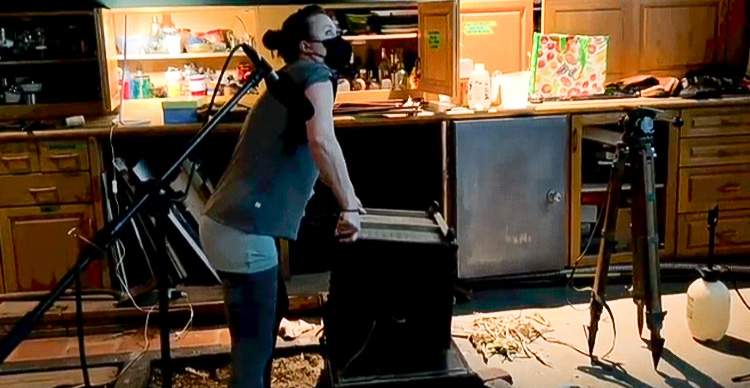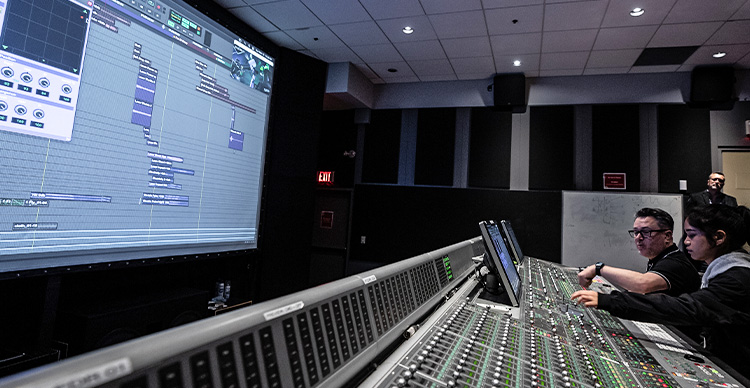Key Takeaways
- Foley artist and VFS alum Diane Schimpl joins Vancouver Film School as a Sound Design for Visual Media instructor, bringing hands-on experience from Netflix, Sony, and Clown in a Cornfield.
- Diane's classes will give students real-world foley training – from footsteps to body-falls – building a practical skill set that mirrors today's industry standards.
- Her journey from student to industry pro is a testament to the power of VFS’s fast-track, production-based training, and the lasting network of industry connections it offers.
Vancouver Film School boasts a faculty of experienced professionals who are pulled from the heart of the creative industry. Masters of their craft, these artists bring current, industry-relevant skills to our production centres, ensuring our students receive the most up-to-date training that matches what the industry is looking for right now.
We are so honoured to welcome industry sound designer Diane Schimpl to our faculty as an instructor for Vancouver Film School’s Sound Design for Visual Media program! A VFS Sound Design alum, Diane has already built an impressive career as a foley artist, working on top industry titles like Netflix’s Sweet Magnolias, Sony Entertainment’s Horizon Forbidden West, and most-recently horror hit Clown in a Cornfield – certified fresh on Rotten Tomatoes.
Welcome to Vancouver Film School, Diane! Our students (and VFS!) are so lucky to have you on the team to help launch the careers of our aspiring sound designers.
OUR EXCLUSIVE INTERVIEW WITH FOLEY ARTIST DIANE SCHIMPL
We were fortunate enough to sit down with Diane to talk about how she got started in the industry, her experience on Clown in a Cornfield, and advice for aspiring sound designers. Read our full interview with this professional sound designer below:
Welcome, Diane! Can you tell us a bit about the Sound Design curriculum you’ll be teaching at VFS?
I’ll be teaching classes on foley, sort of the A-Z on techniques. For those who don’t know, ‘foley’ is the art of recording sound to picture, making all of the sound effects to the character’s movement on screen, be it their footsteps, any objects they touch or pick up, even the sounds of their butts as they sit down or stand up from a seat (as well as the seat/chair itself).
Most people know about using coconuts to make the sound of horse hooves, but there is so much more to foley that is really subtle, and not at all intuitive. Watching a show, you wouldn’t realize that we recorded most of the sounds. It’s going to be quite the challenge to fit it all in to just a few classes per semester, but my aim is to give the students at least a comprehensive base that they can work from and build on in their future careers.
 With industry foley experience across 20+ movies, TV, & games, Diane Schimpl joins VFS’s Sound Design program as an instructor.
With industry foley experience across 20+ movies, TV, & games, Diane Schimpl joins VFS’s Sound Design program as an instructor.How did you get your start in the industry?
I was in the middle of the VFS Sound Design program when COVID-19 hit and shut everything down. I put the program on pause and got back to work in my previous field. Chad Costen, from VFS’s Foundation Visual Art & Design program, reached out as he was looking for someone to cover the foley for one of the shorts he had created leading up to his soon-to-be-released feature Sandman. I jumped at the chance, as the Sound Design program had already taught me the necessary skills I needed to work on such a project.
I was eager that my recently acquired knowledge not go to waste. Long story short, when the former department head, Shane Rees, was looking for a foley assistant for his newly minted Bigfoot Foley Studios, Chad graciously showed him the work I had done for his short, and I got a tryout. After that, it was a mixture of hard work, dedication, and the luck to have fallen in with the talented crew over at Bigfoot Foley.
Working on Clown in a Cornfield must have been the thrill of a lifetime!
Awe man, gory horror is my absolute favourite to cover! In general, I’m a big horror film fan, so any chance to work on one, slasher flick or not, is an absolute treat. But with Clown, there were so many scenes of grizzly death and mayhem, that it was a real delight. The foley stage got real messy, which is the telltale sign that a foley artist has had a good day at work.
I have to say, that when we work on a film, it is to a temp soundtrack and dialogue, so it’s not always apparent how the final piece will play out. Music and sound design have such a large part to play in shifting a picture in one way or another. Watching Clown in a Cornfield on the foley stage, however, even just with the temp, the script and performances were so immediately entertaining that I had a feeling we were working on something fantastic.
I recently had the opportunity to watch the film at its Vancouver premier, and seeing the final result, with the stellar work of the rest of the sound editors and mixer, was truly delightful. If anyone out there enjoys the slasher flick genre, do yourself a favour – don’t miss this one.
Do you have an all-time favourite project?
I can’t say that I have a favourite project. Our work in foley is so granular, we’re focusing on each and every detail of the movement on screen, so it really does become all about the moments. Finding the perfect prop to play for a creepy creaky swing set, or recording punches and body-falls for a fight scene and then layering recordings for the tables they’re falling into, and the glasses smashing, and chairs breaking; these are hugely satisfying moments. But performing a gentle hand on someone’s shoulder, in a tender moment, and getting the sound just right: the impact loud enough to be noticeable in the mix, but still “feel” like a gentle touch to the viewer/listener, can be every bit as gratifying.
What advice do you have for aspiring/emerging sound designers as they navigate their industry careers?
Keep your ears open, always. As you move through your career, you will get more attuned to the minutiae of sounds, in the wild, in the projects you work on, and in the content you watch when you’re “off the clock”. Everything you experience is now the well you draw from. And you now have an excuse to watch every good movie ever made, and also a bunch of the bad ones, so go ahead and do that. Swim in the water of your art. We take for granted so much of how our current films sound, but how they sound in modern day has a genus that you can trace right through to the first ‘talkies’. Knowing your history will always make you a more nuanced and informed creator, and give your work layers of richness.
 VFS’s Sound Design for Visual Media program trains talented artists in audio and sound for film, TV, games & beyond in just 1 short year.
VFS’s Sound Design for Visual Media program trains talented artists in audio and sound for film, TV, games & beyond in just 1 short year. HOW TO BECOME A FOLEY ARTIST IN CANADA
If you’re looking for your fastest path to a career in sound design – the answer is crystal clear. From industry software like Pro Tools to recording, game audio, mixing, editing and more, VFS’s Sound Design program provides a comprehensive, production-focused training taught by industry professionals in world class facilities. And the best part – you’ll graduate in 1 year with a diverse portfolio that will serve as your industry calling card. If this ‘sounds’ like the program for you (pun intended!), book an appointment with a VFS Admissions Advisor to learn more about the program, career paths in film & game audio, tuition costs, scholarships, and all about the VFS student experience.
Read about other recent VFS Sound Design alumni successes, including our Marvel case study, alumni work on the Until Dawn game remake and alumni credits at the 2025 Oscars.
FAQ
1. Who is Diane Schimpl?
Diane Schimpl is a professional foley artist who recently joined VFS’s Sound Design for Visual Media program as an instructor. Her credits include Sweet Magnolias (Netflix), Horizon Forbidden West (Sony), and the hit horror film Clown in a Cornfield.
2. What does a foley artist do in sound design?
Foley is the art of creating and recording sound effects in sync with a character’s movement on screen – footsteps, clothes rustling, doors creaking, and more – to enhance realism and immersion in film, TV, and games.
3. What will Diane be teaching at VFS?
Diane will be instructing students in the art and technique of foley, offering insider knowledge and hands-on experience based on her work in major studio productions.
4. How long is VFS’s Sound Design for Visual Media program?
The program is an intensive 1-year diploma designed to prepare students for careers in film, television, and game audio through production-focused training and portfolio development.
5. How can I apply to the Sound Design program?
You can book an appointment with a VFS Admissions Advisor to learn more about the application process, tuition, scholarships, and the student experience.
